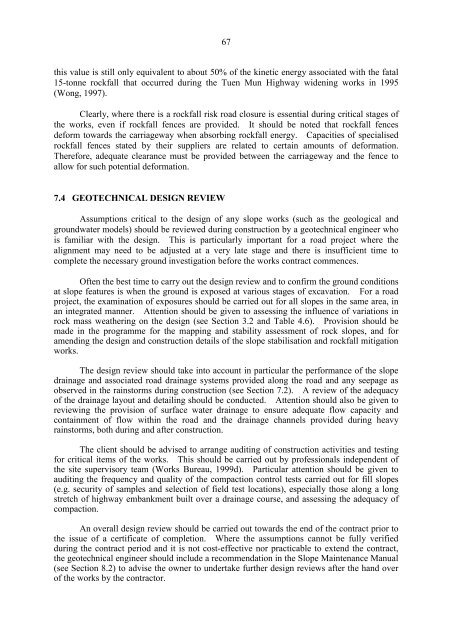Highway Slope Manual
Highway Slope Manual
Highway Slope Manual
You also want an ePaper? Increase the reach of your titles
YUMPU automatically turns print PDFs into web optimized ePapers that Google loves.
67<br />
this value is still only equivalent to about 50 of the kinetic energy associated with the fatal<br />
15-tonne rockfall that occurred during the Tuen Mun <strong>Highway</strong> widening works in 1995<br />
(Wong, 1997).<br />
Clearly, where there is a rockfall risk road closure is essential during critical stages of<br />
the works, even if rockfall fences are provided. It should be noted that rockfall fences<br />
deform towards the carriageway when absorbing rockfall energy. Capacities of specialised<br />
rockfall fences stated by their suppliers are related to certain amounts of deformation.<br />
Therefore, adequate clearance must be provided between the carriageway and the fence to<br />
allow for such potential deformation.<br />
7. GEOECNICAL ESIGN REVIEW<br />
Assumptions critical to the design of any slope works (such as the geological and<br />
groundwater models) should be reviewed during construction by a geotechnical engineer who<br />
is familiar with the design. This is particularly important for a road project where the<br />
alignment may need to be adjusted at a very late stage and there is insufficient time to<br />
complete the necessary ground investigation before the works contract commences.<br />
Often the best time to carry out the design review and to confirm the ground conditions<br />
at slope features is when the ground is exposed at various stages of excavation. For a road<br />
project, the examination of exposures should be carried out for all slopes in the same area, in<br />
an integrated manner. Attention should be given to assessing the influence of variations in<br />
rock mass weathering on the design (see Section 3.2 and Table 4.6). Provision should be<br />
made in the programme for the mapping and stability assessment of rock slopes, and for<br />
amending the design and construction details of the slope stabilisation and rockfall mitigation<br />
works.<br />
The design review should take into account in particular the performance of the slope<br />
drainage and associated road drainage systems provided along the road and any seepage as<br />
observed in the rainstorms during construction (see Section 7.2). A review of the adequacy<br />
of the drainage layout and detailing should be conducted. Attention should also be given to<br />
reviewing the provision of surface water drainage to ensure adequate flow capacity and<br />
containment of flow within the road and the drainage channels provided during heavy<br />
rainstorms, both during and after construction.<br />
The client should be advised to arrange auditing of construction activities and testing<br />
for critical items of the works. This should be carried out by professionals independent of<br />
the site supervisory team (Works Bureau, 1999d). Particular attention should be given to<br />
auditing the frequency and quality of the compaction control tests carried out for fill slopes<br />
(e.g. security of samples and selection of field test locations), especially those along a long<br />
stretch of highway embankment built over a drainage course, and assessing the adequacy of<br />
compaction.<br />
An overall design review should be carried out towards the end of the contract prior to<br />
the issue of a certificate of completion. Where the assumptions cannot be fully verified<br />
during the contract period and it is not cost-effective nor practicable to extend the contract,<br />
the geotechnical engineer should include a recommendation in the <strong>Slope</strong> Maintenance <strong>Manual</strong><br />
(see Section 8.2) to advise the owner to undertake further design reviews after the hand over<br />
of the works by the contractor.

















